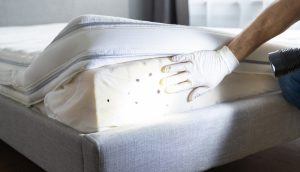Table of Contents
Wondering why bats regularly choose your home as a place to sleep during the day? Bats nest in attics and between walls because these areas offer a warm, dry place to roost. This environment makes it easy for bats to regulate their body temperature while sleeping.
Bats are also hunting for a location close to food and water. While many people believe bats are attracted to exterior lighting, they’re really interested in the moths and mosquitoes swarming them. Standing water, like ponds or lakes, will also draw more bats to your property. So will dense vegetation and night-blooming flowers.
Why Do Bats Go into Attics?
Bats have their preferred nesting areas, and they dislike human encounters — so they’ll avoid them whenever possible. Still, they’ll hide anywhere that’s easily accessible. Small cracks and holes around your home can allow heat to escape, attracting bats. But how do bats get into attics in the first place? They’ll enter your home through attic vents, damaged screens, fascia boards, ridge vents, eaves, or siding.
Once inside, you’ll generally find them hanging upside down in the following areas:
- Attics
- Chimneys
- Walls
- Roofs
What Attracts Bats to Attics?
You might have a bat in your home if you encounter strange smells, find guano piles or urine stains, and hear regular squeaks or chirps. Many bats carry diseases like rabies and histoplasmosis, so removing them from your home is crucial. If you want to get rid of them yourself, it’s wise to contact your local wildlife agency to understand what laws or regulations you should follow.
How to Get Rid of Bats
The safest way to remove a bat from your home is to open all the nearby windows and doors. Clear the space to give the bat time to exit. If it doesn’t leave on its own, you can wait until it lands on your curtain or furniture to try to catch it yourself. You should avoid touching the bat if you can — these approaches can help:
- Grab the bat wearing thick gloves.
- Capture it with a plastic tub and lid.
- Cover it with a blanket.
How to Keep Bats out of Your Attic
Exclusion is the best way to keep bats out of your house. Since they search for small openings to crawl through, you should thoroughly inspect your exterior and fill in any cracks, crevices, holes, and gaps around your windows, roof, or utility vents.
Bigger holes may benefit from bat valves, which allow nesting bats to exit but prevent them from returning. You should place caps on chimneys, screens on windows, and covers on any vents you have. You can use mylar, flash tape, or a caulking compound to fill in any openings bats might use to enter. Make sure every bat is out of your home before you start sealing it up.
Consider the following strategies to prevent bats from entering in the future:
- Turn off bright lights at night.
- Illuminate your attic and other popular nesting sites.
- Remove standing water around your property.
Count on Quest Termite & Pest to Help
If you’re struggling with a bat nest in your attic, the Quest Termite & Pest experts can’t wait to help. We have proudly served the greater Lehigh Valley for decades, striving to be a partner homeowners and businesses can trust to resolve their pest challenges. Contact our team online to learn more about how our services can benefit you!






